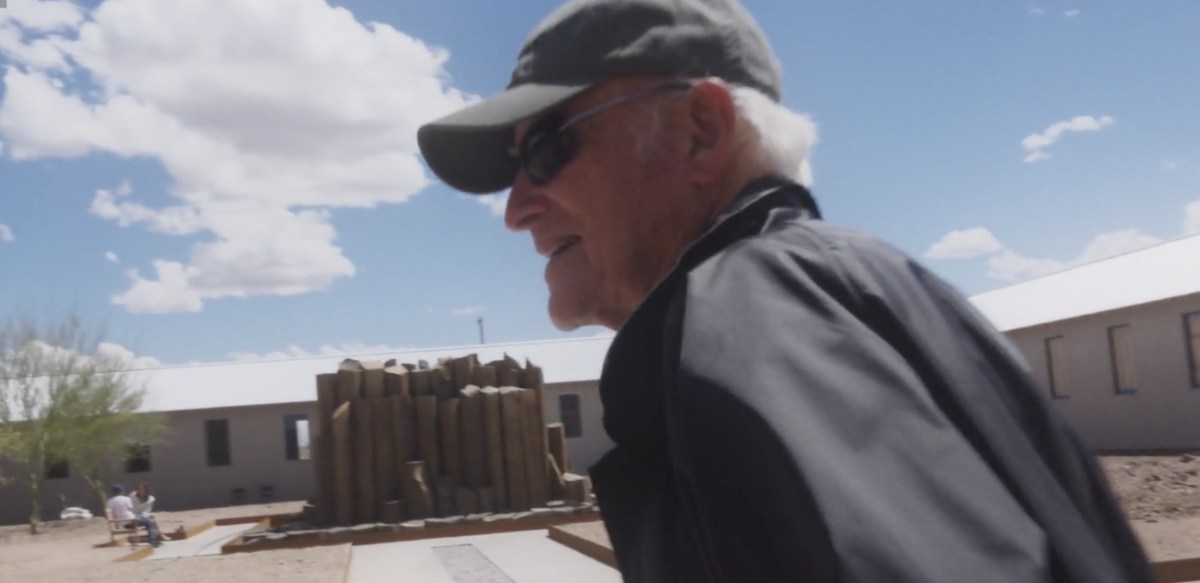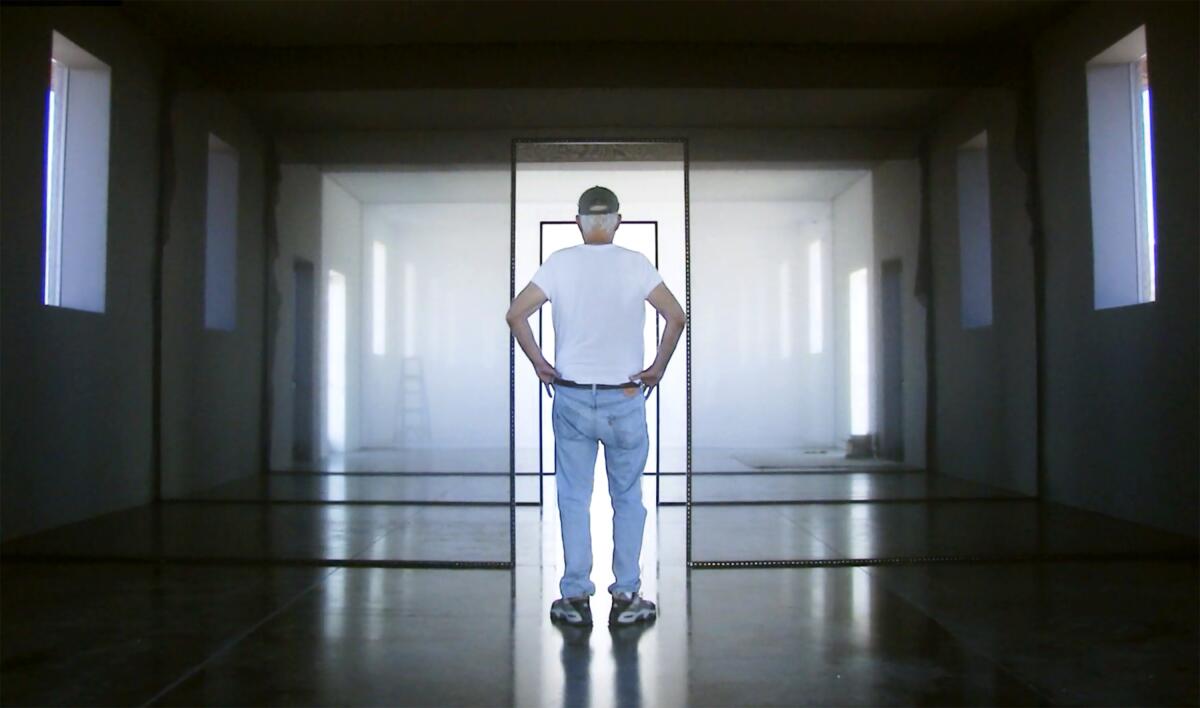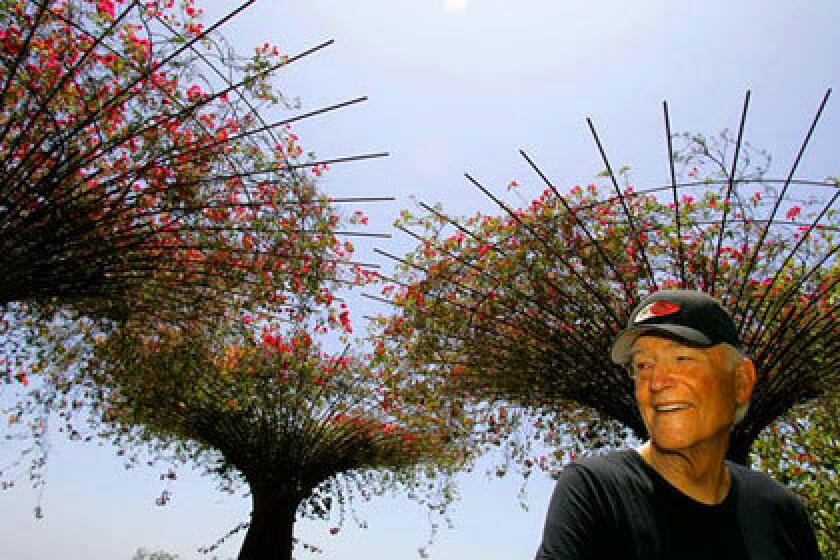Review: A useful but unsatisfying new documentary tackles the career of Light & Space artist Robert Irwin

- Share via
In 2016, the Chinati Foundation in the remote West Texas desert town of Marfa opened “untitled (dawn to dusk),” a massive permanent installation by Southern California artist Robert Irwin, the leading figure of the movement known as Light and Space art. Emerging into its full glory in Los Angeles in the 1960s and early 1970s, and taking varied forms in paintings, sculptures and environments, Light and Space stands as the region’s first wholly original contribution to the history of art.
The Marfa environment, a low-slung, single-story concrete building constructed on the ruins of a military hospital, is explored at the end of “Robert Irwin: A Desert of Pure Feeling,” a 93-minute documentary film from director and editor Jennifer Lane having its Nov. 12 debut at the 13th annual DOC NYC festival. (The title refers to “Suprematist Composition: White on White,” Russian avant-garde artist Kazimir Malevich’s radically nonfigurative 1918 painting of a tilted white square on a square white canvas.) Featuring a total of nearly four dozen Irwin works, the film chronicles the long, often unlikely career of the artist, now 94.
The full arc of artist Robert Irwin’s career is something to behold.
The Texas environment houses two primary elements. One is the shifting ephemera of light streaming through perimeter windows as the sun pushes across the sky during the passage of the day, its illumination harnessed and dispersed by carefully placed scrims of translucent black or white fabric stretched taut inside interior rooms — a signature Irwin format. The other is the elusive quality of space, both contained within the rectilinear, U-shaped building and uncontrolled outdoors in the organic landscape and the sky above, framed through the same windows that let the light in.
Time is embodied in the gentle movement of light through interior rooms and across the landscape, as low and billowy clouds drift by. Irwin compares the scene to 17th century Dutch landscape paintings, like those by Jacob van Ruisdael or Jan van Goyen. Time melds a fourth dimension to the three we identify as essential to understanding space.
“You don’t try to top Mother Nature,” Irwin interjects about site-determined art. “You invite her in.”
These elements, fundamental to human perception, are Irwin’s artistic focus. He was almost 88 when “untitled (dawn to dusk)” was completed, and he had been working on the project for nearly 17 years. The film, useful if finally unsatisfying, tells a narrative of how he got there.

The narrative is well known, at least within the Los Angeles art world. A suburban high school kid more enthralled with bebop than academics, self-taught in phenomenological philosophies, rigorous in paring down painting to its perceptual basics when he finally committed to being an artist, supporting himself through a savvy gambler’s skill at the racetrack and more — “A Desert of Pure Feeling” is structured as a conventional biographical chronology. That predictable form finally conflicts with such unconventional art.
A full exposition of the Marfa piece might have better opened the film, rather than attempting to unveil it at the end as a crowning achievement. The path to get there is long and slow, when it needs to be foreshadowed. Connections among clearly related works from different decades — “untitled (dawn to dusk)” with “Varese Portal Room” (1973-1976) in Italy and “Window Wall for Cal State Long Beach” (1975), for example — are more glancingly implied than examined.
Archival interviews with the artist, mostly from the early 1970s, are a highlight. But the most gorgeous cinematic section comes around three-quarters in, with development of the incomparable 1997 “Central Garden” nestled in a shallow ravine between the J. Paul Getty Museum and the Getty Research Institute. Exquisitely photographed in its mature state, the brilliantly designed garden as site of infamous combat between the artist and Getty Center architect Richard Meier, who had his own more pedestrian garden design in mind, makes one shake one’s head yet again. (“What a disaster,” Meier mutters in defeat as Irwin’s elaborate vision prevails.) That museum officials trusted and stood behind a major artist is an important lesson to share, given the garden’s triumph.
The artist, creator of the controversial gardens, may no longer have design oversight but his vision has established deep roots.
One undercurrent of the film is that Irwin’s monumental achievement as an artist has largely escaped New York, the world’s most provincial art city. Irwin didn’t make a passel of paintings and sculptures that could filter through its splashy marketplace or land inside its many art museums for permanent display. Much of his finest work is determined by the site in which it exists, and those sites are far-flung. Out of sight, out of mind.
Nevertheless, Pace Gallery’s Arne Glimcher, a co-producer and New York interview subject, has been one of the artist’s staunchest supporters. If “A Desert of Pure Feeling” falls short, it does celebrate a critically important artist of our time. The film might take local festivalgoers by surprise.
More to Read
The biggest entertainment stories
Get our big stories about Hollywood, film, television, music, arts, culture and more right in your inbox as soon as they publish.
You may occasionally receive promotional content from the Los Angeles Times.












